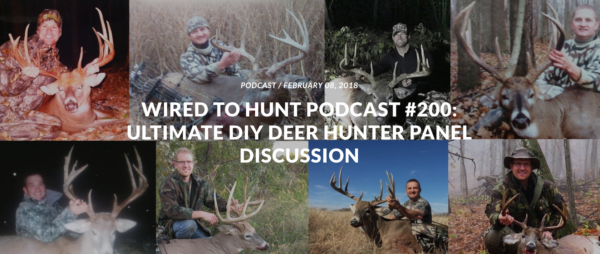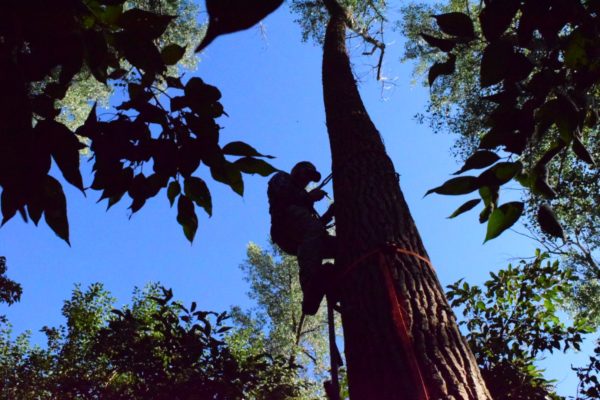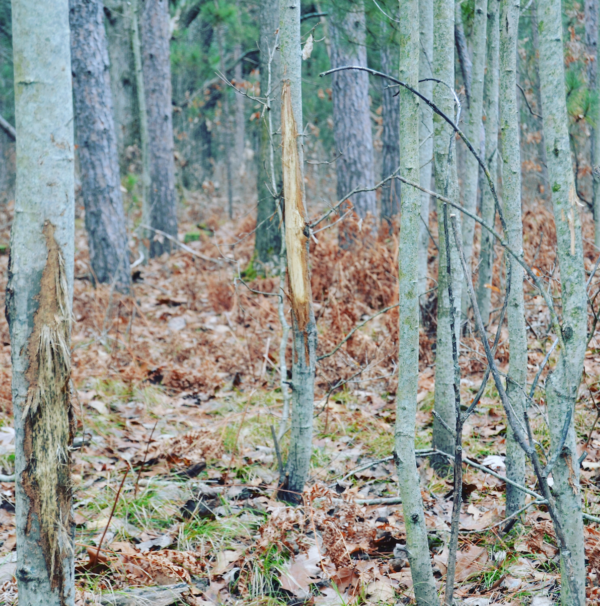
Words by Bob Polanic, Hybrid-Outdoors
For Wired to Hunt’s 200th podcast episode, Mark did a panel discussion (much like the 100th episode) with three outstanding DIY hunters. He interviewed Andy May, Joe Elsinger, and Jesse Coots from Michigan, Iowa, and New York respectively. The episode was two and half hours long, with the last two hours being absolutely jam-packed full of whitetail wisdom. If you can, you should definitely listen to it.
But for those of you who don’t have two hours for this episode, I wanted to create a cliff-notes resource to make sure folks can still benefit from this great interview. And even if you did listen to it, this should be a helpful review. I listened to this podcast three times in order to dissect everything and share with you the most critical tips.
Take a look below for some of the most important topics and lessons covered.
1.) Scouting
The main reoccurring theme with all of these hunters is scouting. Scouting right now, scouting by way of the internet (maps), or scouting during hunting season. All three credit scouting, mainly offseason scouting, to their success during the hunting season. Here are a few highlights on the topic from each of the guests…
Andy on scouting –
- Start scouting in the winter. Look for buck bedding. Get right out there and find ALL the sign.
- Put all the “pieces” together for more effective rut sits in the fall. Spots with combinations of sign are high percentage spots.
- On finding early season buck patterns – running trail cams, do a lot of glassing in the weeks leading up to opening day, and look for big tracks.
- Find 5-6 different good bucks to hunt because “I know I’m going to screw up on a few of them”.
Joe on scouting –
- Scout multiple properties, sort out the best areas, select the top half or top third and hunt those properties that year. Still keep tabs on the properties you’re not hunting for future years.
- As soon as your tag is filled, your boots are back on the ground scouting during the season.
- Hang cameras but let them sit the whole season, observe natural deer movement, and then analyze those movements on how they relate to certain wind directions, weather, hunting pressure, etc. Use this intel for the following hunting seasons.
- During the summer, walk the edges of fields looking for big distinctive mature buck tracks, knowing the mature buck is coming out at night but thinking of what bedding area the tracks might be coming from.
Jesse on scouting –
- Cover ground right now (winter/spring) because you can go places you normally should NOT go. You can bump deer and it doesn’t matter.
- Look for sign that was laid in October/November.
- Don’t look for tons of tracks but look for isolated, big tracks. Most mature bucks are by themselves.
- Glassing for even 10-15 minutes in the morning before work or evening after work equals 10-15 minutes of knowledge you once didn’t have.
2.) Favorite Week to Bow Hunt
Joe – Last week of October
- Bucks aren’t pattern-able anymore but are a little more visible. They are seeking that first doe.
- Bucks might not be full blown seeking, but you may be able to catch him first thing in the morning or last thing in the evening.
- Target his rut bedding, which is going to be in an area where a mature buck can keep an eye on the doe herd. Bedding locations will still be situational due to wind direction.
(Rut bedding – Oldest bucks, in general, have the smallest core area. He’s likely to favor locations closer to doe bedding. He’s observing with his nose what is going on. You probably can’t hunt in the exact spot near his rut bed. Most common mistake hunters make is setting up on top of the sign where a buck observes most of whats going on with his nose, he smells you before you even see him, which is exactly why he’s stayed alive as long as he has.)
Jesse –
- In his highly pressured home state of NY, he prefers the first week. If he’s done his homework, he has a good chance at getting a crack at a mature buck right away.
- Out of state hunting in the midwest, he recommends hunting that 2nd week of November. If you’re a nonresident with limited knowledge of the area, think Nov. 7th through the 18th. “End of November is when the true giants show up.”
Andy –
- When in MI, the first week of the season. Again, if he’s done his homework he should have an idea where to encounter a mature buck.
- Out of state, he likes November 5th to the 12th. He’s seen a lot of midday kills during that timeframe.
3.) Preseason Scouting for Opening Day
- Doing a lot of glassing. The two week period before opening day of bow season, try to find a buck or two that is showing some sign of evening daylight movement. Set up off the food source and tighter to bedding cover, could be within 50 yards or maybe 100 yards. If you can get back into the security cover, they will move, but its a balancing act of how close can you get without getting busted.
- Its hard to kill mature bucks on a food source (in heavily pressured areas). Your best chances are getting it done close to bedding. You’ve got to stay undetected from the deer that move early because mature bucks will be the last to move out of bedding toward a food source.
- Early season, you have to be right on top of the deer movement changes. Deer patterns can change in just a days time during the early season due to changing food sources. If you observe a buck movement in the morning, move in closer on him for the very next hunt knowing you’re either going to kill him or blow him out. Take calculated risks and make mistakes, just know it’s a journey that takes time to get to the point of knowing when it’s right to be aggressive.
4.) Wind
- Think about how the wind will favor deer over you. You’re not going to kill mature bucks with the wind favoring you.
- Hunt crosswinds that favor deer over you.
- Mature bucks will usually J-hook around their bedding to smell for any danger before entering.
- Mature bucks will stay 150-200 yds downwind of known hunting spots where they have smelled a hunter before.
Conclusion
There’s a lot more info packed into this podcast than what I’ve shared. The stories each one shares and the lessons we can learn from their experiences could be another lengthy blog post. By listening to this podcast a few times, there are a few main points that stuck out.
- Off season scouting is the most vital piece to the puzzle. You must find buck bedding.
- You need to hunt close to buck bedding (in heavily pressured scenarios like these guys hunt). Hunting close to buck bedding is high risk, high reward. Be quiet but be aggressive.
- Hunt with the wind in their favor. As hard as this sounds, it makes a lot of sense.
- Try to pattern a deer before the season opens.
I hope this breakdown of the podcast helps you as much as it does me. There’s a lot of info to keep straight from these three hunters and I thought it was too valuable to not be written out for future reference.
And if you can, be sure to listen to the full interview at least once, if not twice!







